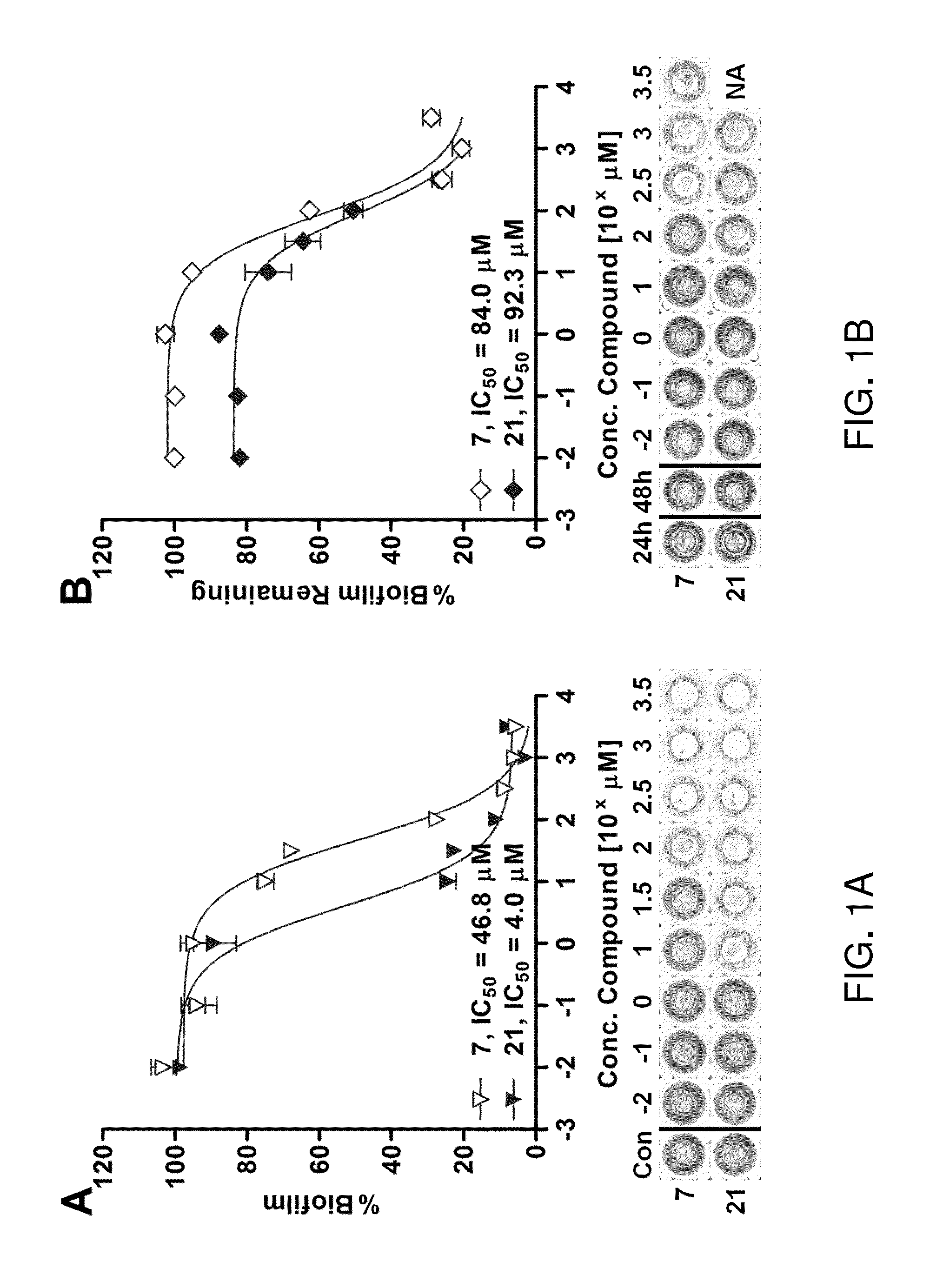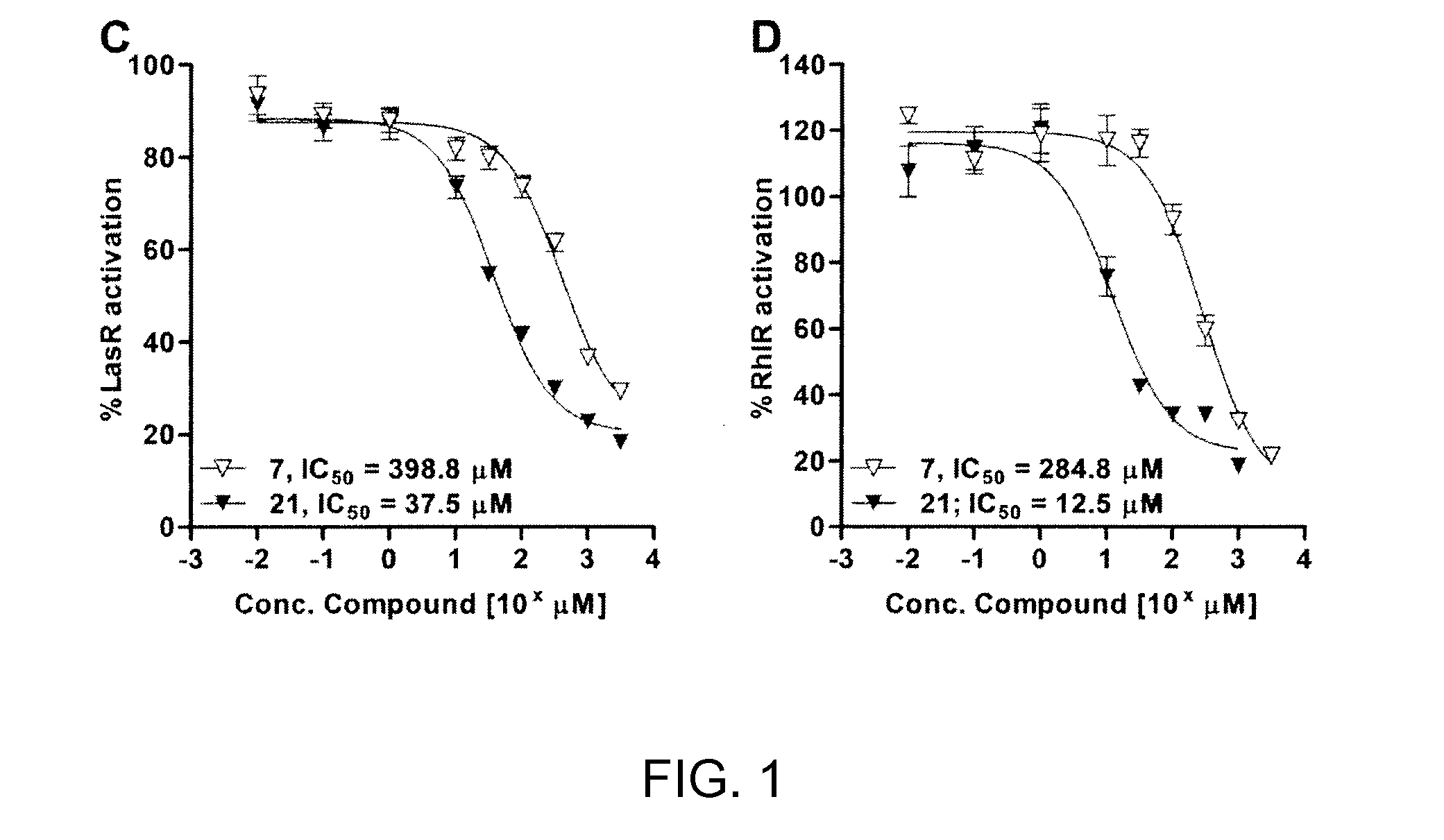Inhibition and Dispersion of Bacterial Biofilms with 2-Aminobenzimidazole Derivatives
a technology of bacterial biofilms and derivatives, applied in the field of inhibition and dispersion of bacterial biofilms with 2aminobenzimidazole derivatives, can solve the problems of biofilms being particularly problematic, bacterial growth poses a significant obstacle to the successful treatment, and molecules exhibiting these properties remain rare, so as to reduce the virulence of bacterial infections and increase the susceptibility of quorum sensing bacteria
- Summary
- Abstract
- Description
- Claims
- Application Information
AI Technical Summary
Benefits of technology
Problems solved by technology
Method used
Image
Examples
example 1
Compound Synthesis and Characterization Data
A. 2-Nitro-4-styrylaniline
[0171]
[0172]2-Nitro-4-styrylaniline was synthesized according to a modified version of a reported procedure. [35] In brief, 4-iodo-2-nitroaniline (500 mg, 1.89 mmol, 1.0 eq.) and palladium (II) acetate (Pd(OAc)2, 21.3 mg, 0.095 mmol, 0.05 eq.) were added to an oven-dried Pyrex tube equipped with a magnetic stir bar at room temperature (rt). The tube was purged three times via three sequential vacuum / N2 back-fill cycles. Next, freshly distilled styrene (260 μL, 2.27 mmol, 1.2 eq.), N,N-diisopropylethylamine (DIPEA, 825 μL, 4.74 mmol, 2.5 eq.), and acetonitrile (CH3CN, 5 mL) were added under an N2 atmosphere, and the reaction mixture was heated at 80° C. for 24 h. Upon cooling to rt, the solvent was removed in vacuo, and the resulting crude solid was adsorbed onto Florisil gel from a tetrahydrofuran (THF) solution. The resulting powder was dry-loaded on top of a silica gel column that was slurry-packed with ethyl ac...
example 2
Biological Assays
A. General.
[0248]Standard solvents, salts, and media were purchased from commercial sources and used as received. The HCl salt of synthetic compounds were used for biological evaluation if available; however, control experiments indicated that the HCl salt and the non-HCl versions had identical biological activities (data not shown). All biological assays were performed in untreated, flat-bottomed polystyrene 96-well microtiter plates (Costar 3370).
[0249]Absorbance and fluorescence measurements were obtained using a BioTek Synergy 2 plate reader running Gen 5 1.05 software. Spectroscopic measurements were made in 200 μL of media in 96-well microtiter plates (path length of ˜0.5 cm) unless otherwise noted. Bacterial growth was assessed by measuring the culture cell density according to absorbance at 600 nm (OD600). Biofilm was quantified by crystal violet (CV) staining according to absorbance at 590 nm (A590). All reported CV measurements represent the amount of surf...
example 3
Results of P. aeruginosa Biofilm Assay (Compounds 1, 2, and 4-24)
[0265]Compounds were initially assessed for their P. aeruginosa biofilm modulatory activity at 500 μM using the CV assay described above. Test plates were prepared by making 1 mM EtOH stock solutions and adding 100 μL aliquots to the wells of 96-well microtiter plates. All compounds were tested in replicates of 6 wells and were assessed after 12 and 24 h of incubation. The assay data for compounds 1, 2, and 4-24 are shown in FIG. 2A-C.
PUM
| Property | Measurement | Unit |
|---|---|---|
| Antimicrobial properties | aaaaa | aaaaa |
Abstract
Description
Claims
Application Information
 Login to View More
Login to View More - R&D
- Intellectual Property
- Life Sciences
- Materials
- Tech Scout
- Unparalleled Data Quality
- Higher Quality Content
- 60% Fewer Hallucinations
Browse by: Latest US Patents, China's latest patents, Technical Efficacy Thesaurus, Application Domain, Technology Topic, Popular Technical Reports.
© 2025 PatSnap. All rights reserved.Legal|Privacy policy|Modern Slavery Act Transparency Statement|Sitemap|About US| Contact US: help@patsnap.com



